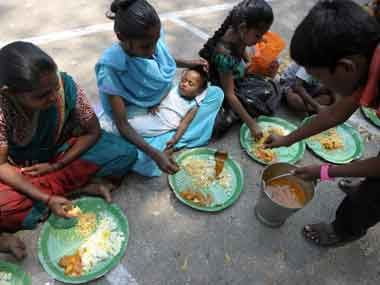Meaning, “The one, whose diet and movements are balanced, whose actions are proper, whose hours of sleeping and waking up are regular, and who follows the path of meditation, is the destroyer of pain or unhappiness.”

Representational image. AFP
This wisdom holds to date and has been validated by modern scientific research and analysis of data. The Bhagwad Gita also says, “Anna mayamhi Soumya manaha,” which means our mind is made up of the food we eat, re-emphasising further the historical significance of nutrition.
However, despite a 50% increase in GDP since 1991, India has not been able to overcome its nutritional challenges. More than one-third of the world’s malnourished children live in India and even after 70 years of independence, we have around 46.6 million stunted and 25.5 million wasted children in the country.
According to the World Health Organization (WHO), malnutrition refers to deficiencies, excesses, or imbalances in a person’s intake of energy and/or nutrients. Investment in nutrition is one of the most effective entry points for enhancing the overall development status of a country, with an estimated benefit-cost ratio of about 16:1 for low- and middle-income countries.
The Prime Minister’s Overarching Scheme for Holistic Nutrition (POSHAN) Abhiyaan is a strategy for addressing malnutrition by focusing on under-nutrition by adopting a life-cycle approach. It was launched by Prime Minister Narendra Modi on 8 March 2018 with an initial three-year budget of Rs 9046.17 crores. POSHAN Abhiyaan is a monitoring and reviewing initiative for taking stock of monitorable indicators of nutrition-centric schemes and programs requiring convergent actions. POSHAN Abhiyaan targets to reduce stunting, under-nutrition, anaemia (among young children, women and adolescent girls) and reduce low birth weight by 2%, 2%, 3% and 2% per annum respectively. Behaviour Change and Communication (BCC), Information, Education and Communication (IEC) advocacy, training and capacity building, innovations, incentives and grievance redressal are the key pillars of POSHAN Abhiyaan.
Severe Acute Malnutrition (SAM) is defined by very low weight-for-height/length and is an important subcategory of malnutrition that is on the rise. It is estimated that around 93.4 lakh children in India are suffering from SAM (NFHS IV).
SAM is an important preventable and treatable cause of morbidity and mortality in children below five years of age. In India, most children with SAM are treated at the facility-level, also called the Nutrition Rehabilitation Centre (NRC). Additionally, successful efforts are also being made in a few states to address SAM through community-based management through the Anganwadi Workers (AWW) either through Village Health and Nutrition Days (VHNDs) or through frequent home visits.
POSHAN Abhiyaan is not a programme but a ‘jan andolan‘ and ‘bhagidaari‘, which means it is a ‘people’s movement’. To give momentum to POSHAN Abhiyan, the National Council on India’s Nutrition Challenges decided to celebrate the month of September as Rashtriya POSHAN Maah.
Every year, during this month, activities related to nutrition awareness are carried out by all the states and Union Territories right from the grassroots level. Activities during POSHAN Maah centres on social behavioural change and communication. The theme from 2018 to 2019 has evolved from ‘Har Ghar Poshan Tyohar‘ to ‘Har Ghar Poshan Vyavahar‘.
This year, the five key focus areas identified for POSHAN Maah by the Ministry of Women and Child Development are as follows: first 1000 days of a child, anaemia, diarrhoea, hand wash and sanitation, and ‘poshtik aahar‘.
Very often, stunting affects a child within two years of age, and the damage done tends to be largely irreparable in the long run affecting the physical, cognitive and socioeconomic outcomes of the child in his/her adulthood. Thus, the focus on the first 1000 days as the first sutra is a commendable step in the right direction.
While the POSHAN Maah activities focus on informing communities on adequate nutrition, POSHAN Abhiyaan through specific strategies such as technology-based real-time monitoring of service delivery, and food fortification is enabling improved access to supplementary nutrition for women and children, and provision of micronutrients to combat hidden hunger.
Last year, more than 12.2 crore women, 6.2 crore men and over 13 crore children were reached through the various activities undertaken during POSHAN Maah. It is worth mentioning that 30.6 crore people were reached in 30 days last year and this number is anticipated to be even higher this year.
Overall, POSHAN Maah has given a major impetus to the Abhiyaan. Let us hope that in due course of time through POSHAN Abhiyaan India reaches a stage where “The doctors of the future will no longer treat the human frame with drugs, but rather cure and prevent disease with nutrition.”
[“source=firstpost”]

